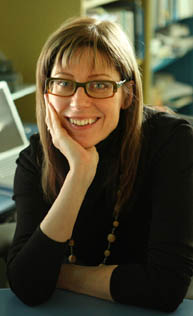PROFILE
Renée Sieber: Informing the people and the planet

Renée Sieber; research that casts a wide (inter)net.
Owen Egan
"Even Amerindians in the Amazon basin are plugging into the Internet," says geography professor Dr. Renée Sieber. She explains that researchers are helping Amazon communities track forest conditions by uploading digital maps of what they see on the ground day by day and year by year.
While there are millions of people with Internet access, Sieber says that simply being on-line is not equivalent to being empowered. In this singular case, "Google Earth grants the Amerindians privileged access to historical geographic data to make comparison maps, which make powerful lobbying tools for forest conservation."
Evaluating whether tools make life easier for marginal communities is a central goal of Sieber's work. Despite sophisticated connections and increased accessibility, the so-called ‘digital divide' is "a real gulf. Because of socioeconomic burdens or political barriers, some communities may never achieve their goals even with information at their fingertips," says Sieber.
The use and value of information and communication technologies for communities and social movements is Professor Sieber's area of expertise. But she is tech-savvy in many ways.
She maintains a blog (http://rose.geog.mcgill.ca) and counts Craig Newmark (craigslist.org founder) among her friends. The upcoming Spatial Knowledge and Information Canada conference that will gather the nation's leading Geographic Information Science (GIS) researchers in Fernie, BC, is largely her brainchild.
With a joint appointment in the Department of Geography and the School of Environment, Sieber is the epitome of an interdisciplinary researcher, studying social and environmental issues using a pot-pourri of tools such as GIS technology, e-commerce and the Internet.
Challenging the status quo
Her work, and that conducted by her lab group, even goes so far as to challenge the conventions of Western thinking in geography altogether.
Chris Wellen, a master's student in Sieber's lab, is researching geographic information and maps used by the Cree First Nations of Wemindji, Que. His work is referred to as "geospatial ontologies," though he summarizes it with the philosophical question: "Do mountains exist, or are they an arbitrary delineation of a continuous landscape?"
Water offers a good example of how the categorizing of information can matter as much as the information itself. Geographers represent water in terms of definite lines, levels, etc. The Cree, on the other hand, consider how "water supplies a route to vegetation and a mode of transportation—their maps of rapids where people portage canoes incorporates land and water." This conflict of categorizations results often stymies outside efforts to protect the natural environment the Cree depend upon.
She is planning a research project exploring the benefits of cellphone communications proliferating across Africa. "Family members are more mobile when far-away work opportunities arise because they can still ‘stay close' with loved ones," she says.
"I found a tailor in Tanzania who uses text messages to inform his clients when a new bolt of cloth arrives," says Sieber. Like untold thousands of other entrepeneurs, "he is exploiting mobile technologies to make economic leaps and bounds." She adds that cellphone charging stations and rental outlets have emerged in the bush to support the exploding use of phones in the developing world.
In the developed world as well, communications are a lynchpin in day-to-day interactions. Sieber is interested in how virtual tools (such as Blackberry wireless devices) are wedging themselves in among traditional means of social interaction (in a meeting over coffee, for example).
One community that can benefit greatly from enhanced familiarity with "pushing information on the right decision makers" is non-governmental organizations (NGOs) working on climate change, says Sieber. When the United Nations annual summit on climate change was held in Montreal in 2005, she went with a team of undergraduates to research the mix of physical and virtual activities that NGOs use. "The tricky question is, when can an email substitute for a phone call or a chat at a conference? Is there a right time and a right place, or do you always lose something essential?" asks Sieber.
The analysis concludes that Internet communication tools are valuable assets that save time, money, and even carbon emissions. These are all significant expenditures, especially when travelling by airplane to a climate change conference. However, when it comes to first impressions and ‘sealing the deal,' interacting in person is paramount for influencing policy.
"After all," says Sieber, quoting a cartoon with two house pets typing on a computer, "on the Internet, nobody knows you're a dog."

